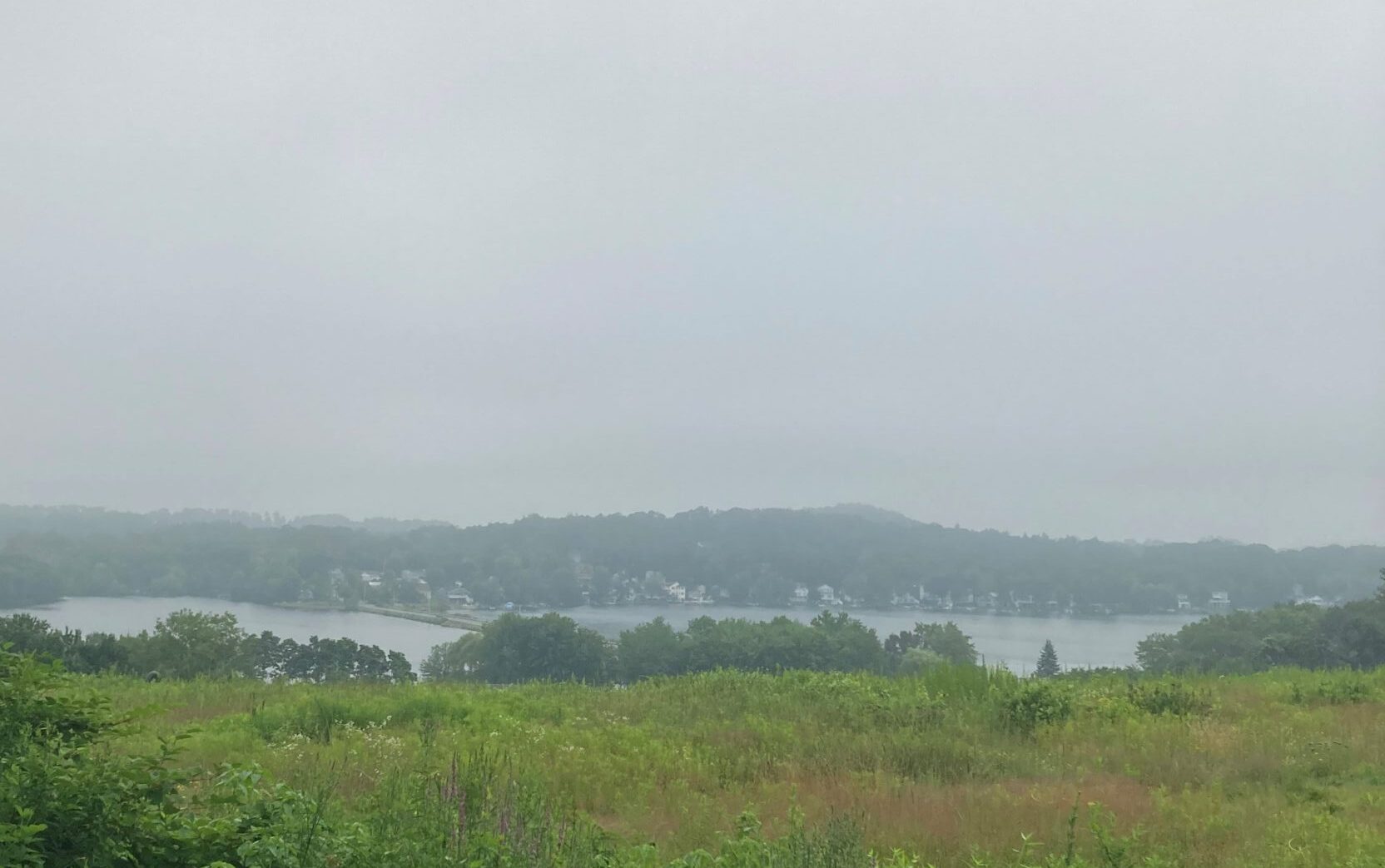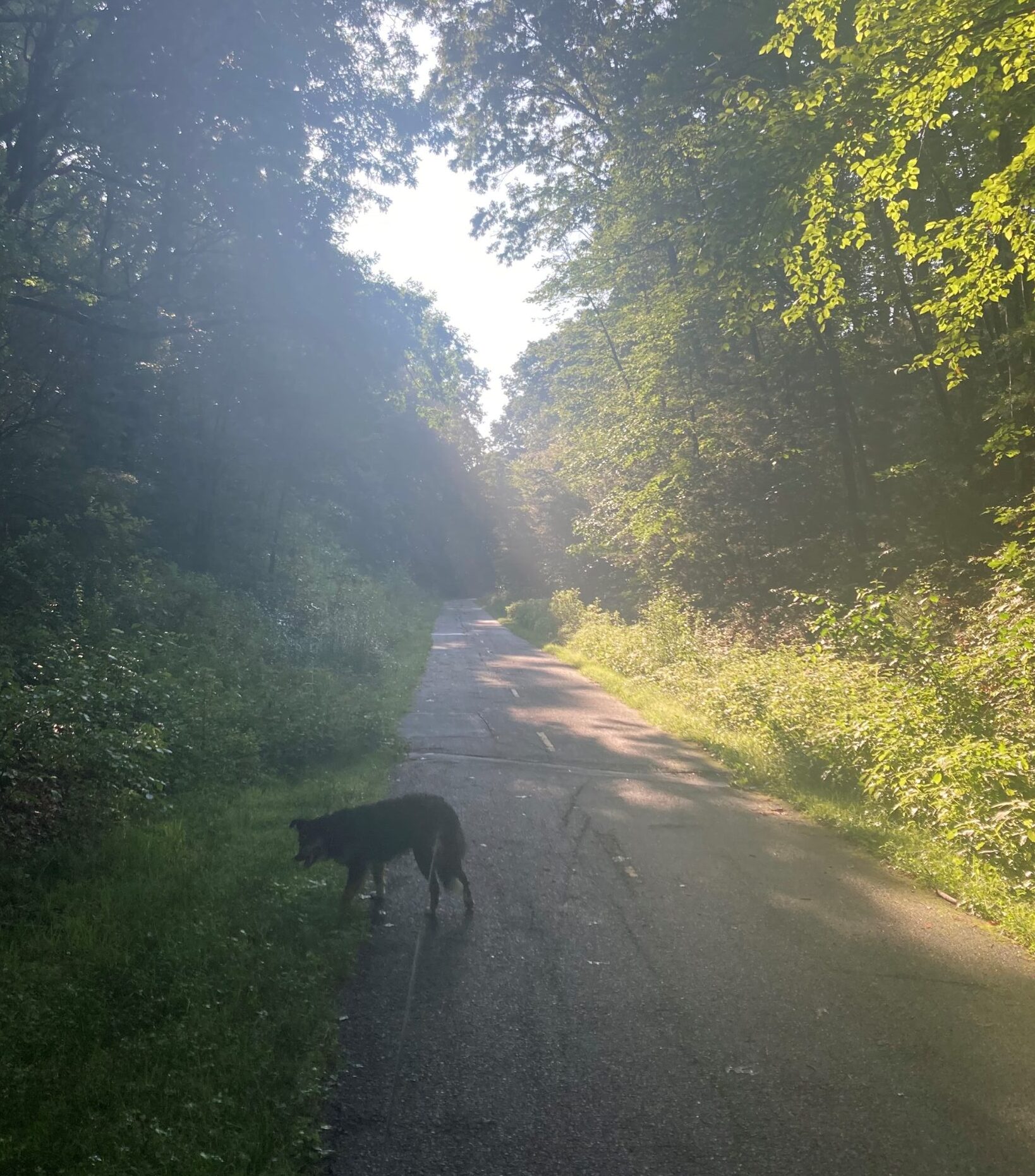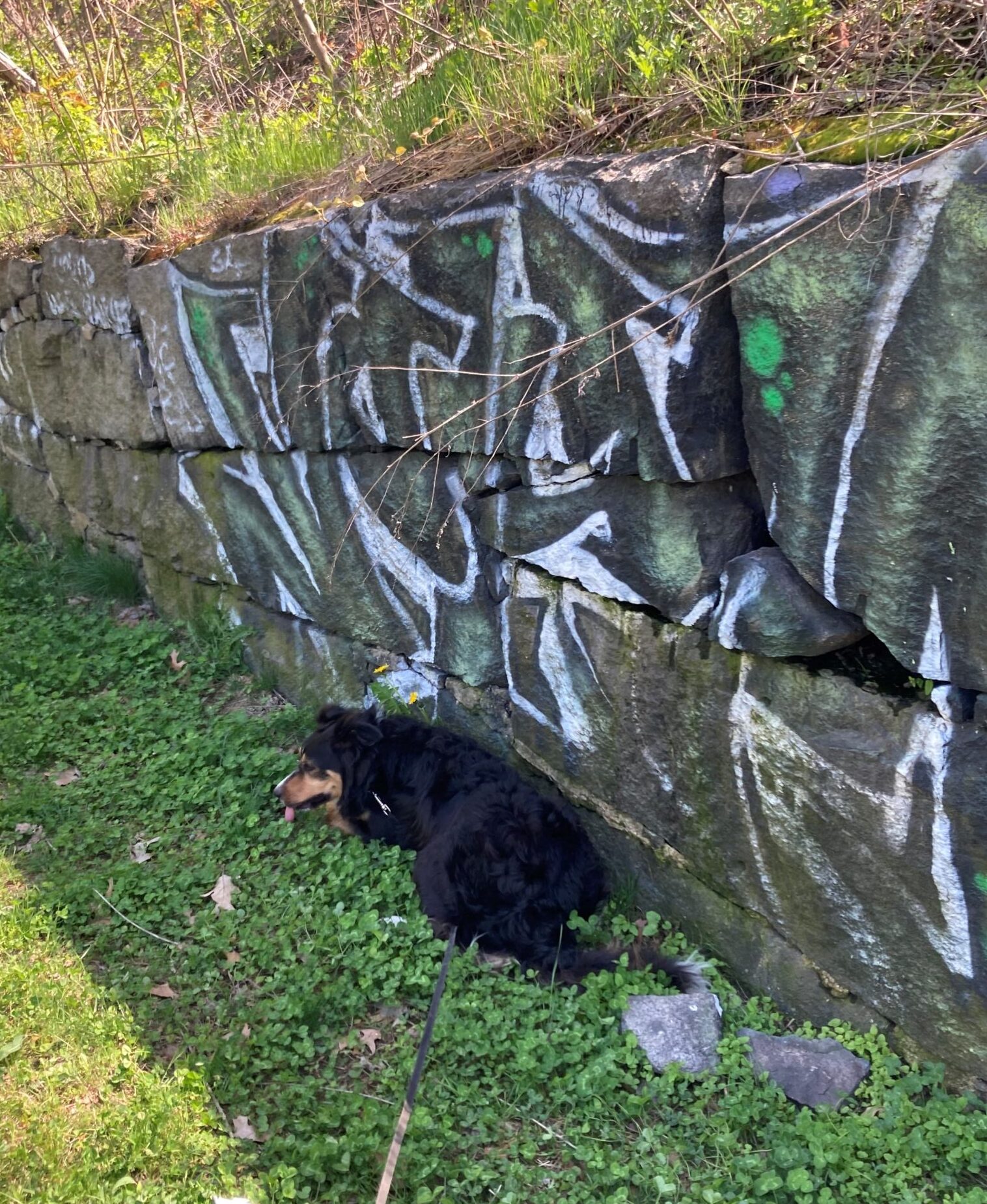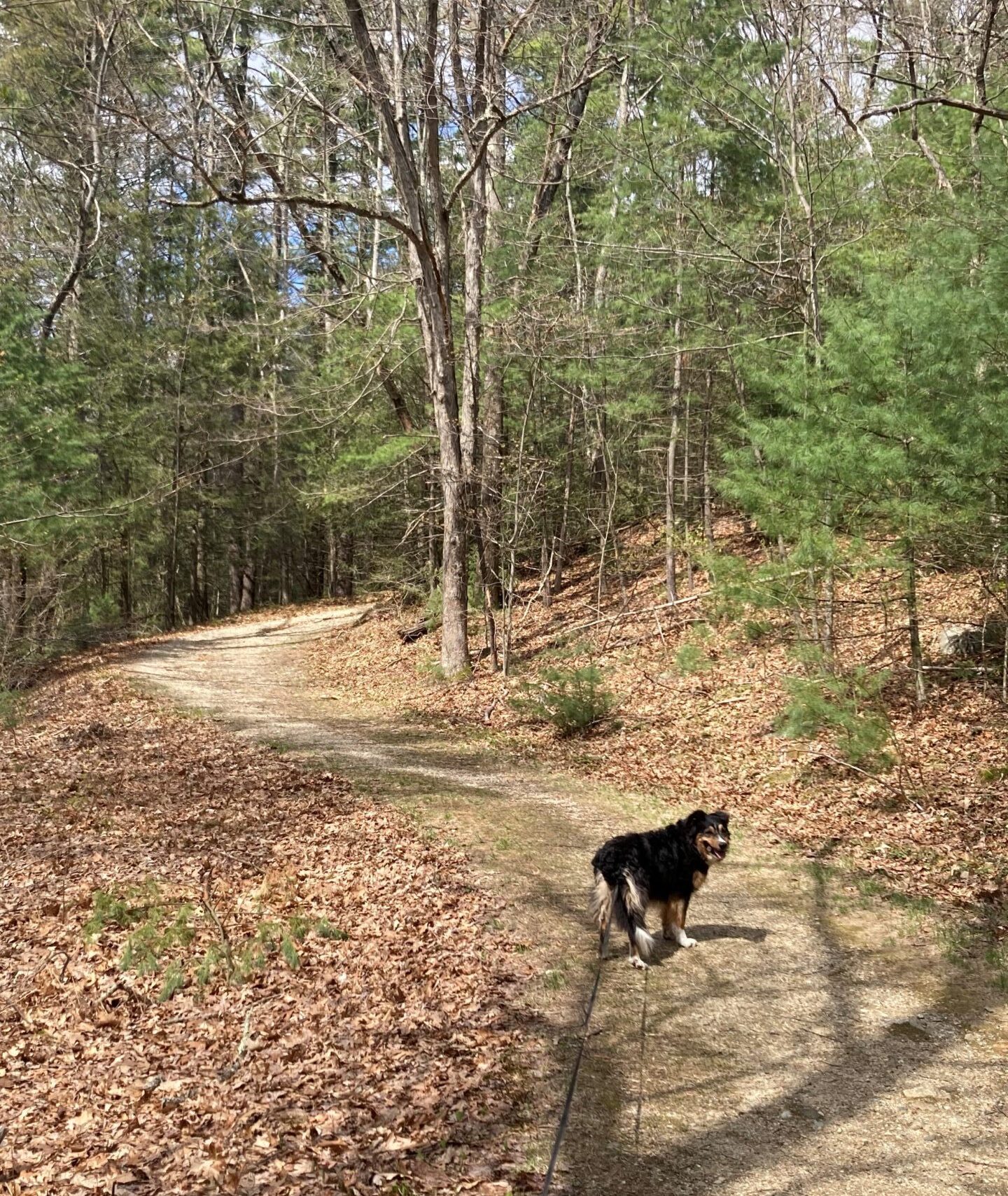May freedom be seen, not as the right to do as we please, but as the opportunity to please to do what is right.
-Peter Marshall
Smoke from the Canadian wildfires has invaded our airspace. The Air Quality Index is 122, which makes it bad for people who are sensitive. The air smells a little like smoke from a wood fire and it’s dense like fog, but not colored like smog. Visibility is limited to about a mile to a mile and a half. It’s muggy out, but there is no forecast of rain today, which is a pity as that would clean the air, for sure. The temperature is in the high sixties and I’m sweating pretty good. Shadows are only vaguely present, due to sunlight being so strongly scattered by the smoke – there is only a slight brightening off toward the east, nothing that would reveal the location of the sun.
Waldo’s sniffing around on both sides of the trail, wandering off into the weeds, exploring whatever it is he finds interesting. He’s on a twenty-six-foot leash, so he has plenty of freedom to go about doing his Waldo thing without much impediment. But he’s not totally free. Keeping him on a tether allows me to keep him safe when he encounters aggressive dogs, or gets the notion to charge off to somewhere that could put him in danger. The leash is a compromise. I sometimes feel guilty for not being able to provide Waldo with large open fields, where he can run at will, and flocks of sheep he can herd and boss around. But either there are many more border collies out there than there are farms and pastures, or there damn well ought to be. Waldo is a wonderful friend and I’m so happy to have him in my life.
Freedom is a funny thing and hard to adequately define. In a very real sense, it is entirely a state of mind. You may not be physically free to do something you’d like to do, like I would like to travel more than I can afford to, or you may be forced to do something you really don’t want to, like pay taxes, but that doesn’t mean you can’t feel free. I remember, years ago, when I returned to the US, at age fourteen, after spending 18 months living in Ethiopia with my family. My life felt different, although very familiar. My memory told me that when I was in East Africa, I was happier and I wondered why. Some of that was obvious, the sense of adventure was exquisite and spoiled me forever. But there was something else as well. Searching my soul to see what that something else was, I discovered that I felt freer there than here. Politically, Ethiopia has never been, and is not now, freer that the US. And being a young teenager without the opportunity or ability to drive myself around, I had to wonder what this sense of freedom was all about.
When I returned to Ethiopia, at the age of twenty-one, for another two-year visit, that feeling was there, brought to the surface from the depths of my subconscious. One day, some friends and I were stopped by a policeman in the city of Gondar. There are no police cars or police motorcycles that patrol the streets and roads, the man simply stood out in front of us and held up his hand. We stopped and asked what he wanted.
I don’t remember how many of us there were, but there enough of us that we all couldn’t fit inside one vehicle (we had a Land Rover). We left Asmara, some three hundred miles to the north, in two cars and a truck. One of our vehicles had mechanical problems and was getting repaired. We didn’t want to take the truck to the restaurant we were going to for dinner, so we all piled into and onto the Land Rover as best we could – three or four of us hanging onto the back, standing on the running board, and sitting on the hood. The policeman was angry about that and shouted at us. We didn’t understand why he reacted that way because nearly every bus on the road had people hanging precariously on them in a more dangerous way than what we were doing. The policeman responded by rebuking us with, “You wouldn’t do that in your country, but you come over here and do whatever you want!” We apologized, but still confused, and made adjustments to our mode of transportation.
Thinking about that later, I decided the man had a point. We tried to be respectful of how the people of our host country lived and thought, but we didn’t always get it right. In this case, I think the cop was offended by the fact that we, guests in his world, didn’t feel constrained by the normative values of his culture, although we didn’t violate any. And we didn’t feel constrained by them at all, other than to be respectful of them.
Human beings, most of them anyway, carry around in their subconsciouses a set of cultural normative values. They’re implanted in us at an early age and we can’t escape them. We always carry them around with us – you can leave your country, but you can never escape your culture. I always subconsciously feel that there is a collection of shoulds and shouldn’ts that I am responsible to. If I violate them, guilt will follow, to some degree. I also have this subliminal feeling that the eyes of my culture are on me, watching how I behave. Eyes that will tsk and shame if I don’t toe the line. All of this is totally in my head and has no substance in physical reality, but it’s real, just the same. But those watchers and censures are not always so obviously manifest.
When I came to Ethiopia, everything was so different and foreign to me. From the language spoken, to the food eaten, the clothing worn and most peoples’ very way of life, none of it felt like it was mine. I didn’t feel responsible to the cultural pressures that were applied to me from the host culture (mine was somewhat smothered by the adventure of it all) to subliminally keep me in line. It was like the lid of a pressure cooker had been removed. And as a young teenager, and later as a young man in his early twenties, exploring the limits of what life had to offer, it was heaven.
Waldo is not free, for sure, but who of us, living in twenty-first century urban environments, is? I try to find places where I can let Waldo off leash, like fenced in ballparks, at least sometimes, but mostly, it’s just him and me, out in the world, tethered together by a synthetic umbilical cord that binds as together as a unit. He may not be free, exactly, but he is happy, even though he lives in a city.
And so am I.





















